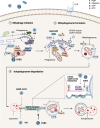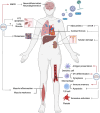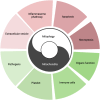Mechanism and role of mitophagy in the development of severe infection
- PMID: 38374038
- PMCID: PMC10876966
- DOI: 10.1038/s41420-024-01844-4
Mechanism and role of mitophagy in the development of severe infection
Abstract
Mitochondria produce adenosine triphosphate and potentially contribute to proinflammatory responses and cell death. Mitophagy, as a conservative phenomenon, scavenges waste mitochondria and their components in the cell. Recent studies suggest that severe infections develop alongside mitochondrial dysfunction and mitophagy abnormalities. Restoring mitophagy protects against excessive inflammation and multiple organ failure in sepsis. Here, we review the normal mitophagy process, its interaction with invading microorganisms and the immune system, and summarize the mechanism of mitophagy dysfunction during severe infection. We highlight critical role of normal mitophagy in preventing severe infection.
© 2024. The Author(s).
Conflict of interest statement
The authors declare no competing interests.
Figures




Similar articles
-
Mechanism of Mitophagy and Its Role in Sepsis Induced Organ Dysfunction: A Review.Front Cell Dev Biol. 2021 Jun 7;9:664896. doi: 10.3389/fcell.2021.664896. eCollection 2021. Front Cell Dev Biol. 2021. PMID: 34164394 Free PMC article. Review.
-
Mitochondrial quality control mechanisms as potential therapeutic targets in sepsis-induced multiple organ failure.J Mol Med (Berl). 2019 Apr;97(4):451-462. doi: 10.1007/s00109-019-01756-2. Epub 2019 Feb 21. J Mol Med (Berl). 2019. PMID: 30788535 Review.
-
Hydrogen alleviates cell damage and acute lung injury in sepsis via PINK1/Parkin-mediated mitophagy.Inflamm Res. 2021 Aug;70(8):915-930. doi: 10.1007/s00011-021-01481-y. Epub 2021 Jul 10. Inflamm Res. 2021. PMID: 34244821
-
The role of mitochondrial dysfunction in sepsis-induced multi-organ failure.Virulence. 2014 Jan 1;5(1):66-72. doi: 10.4161/viru.26907. Epub 2013 Nov 1. Virulence. 2014. PMID: 24185508 Free PMC article. Review.
-
The role of mitophagy in pulmonary sepsis.Mitochondrion. 2021 Jul;59:63-75. doi: 10.1016/j.mito.2021.04.009. Epub 2021 Apr 22. Mitochondrion. 2021. PMID: 33894359 Review.
Cited by
-
Sepsis-induced cardiac dysfunction: mitochondria and energy metabolism.Intensive Care Med Exp. 2025 Feb 18;13(1):20. doi: 10.1186/s40635-025-00728-w. Intensive Care Med Exp. 2025. PMID: 39966268 Free PMC article. Review.
-
Molecular regulation of mitophagy signaling in tumor microenvironment and its targeting for cancer therapy.Cytokine Growth Factor Rev. 2025 Jan 17:S1359-6101(25)00004-8. doi: 10.1016/j.cytogfr.2025.01.004. Online ahead of print. Cytokine Growth Factor Rev. 2025. PMID: 39880721 Review.
-
The Critical Role of Autophagy and Phagocytosis in the Aging Brain.Int J Mol Sci. 2024 Dec 25;26(1):57. doi: 10.3390/ijms26010057. Int J Mol Sci. 2024. PMID: 39795916 Free PMC article. Review.
-
Insights on the crosstalk among different cell death mechanisms.Cell Death Discov. 2025 Feb 10;11(1):56. doi: 10.1038/s41420-025-02328-9. Cell Death Discov. 2025. PMID: 39929794 Free PMC article. Review.
-
P2Y6R Inhibition Induces Microglial M2 Polarization by Promoting PINK1/Parkin-Dependent Mitophagy After Spinal Cord Injury.Mol Neurobiol. 2025 Jun;62(6):7054-7074. doi: 10.1007/s12035-024-04631-5. Epub 2024 Nov 28. Mol Neurobiol. 2025. PMID: 39607640
References
Publication types
Grants and funding
LinkOut - more resources
Full Text Sources

